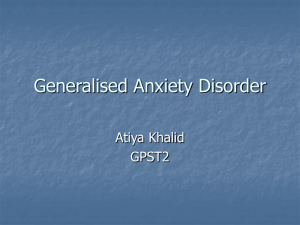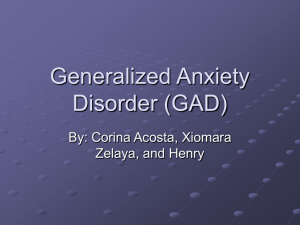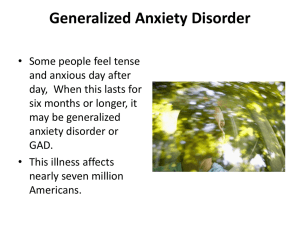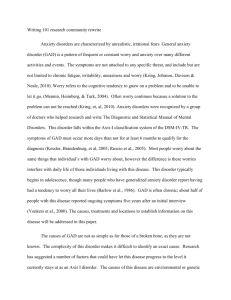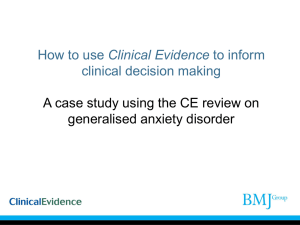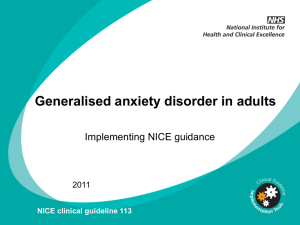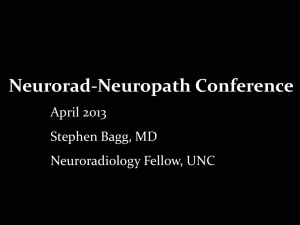Generalized Anxiety Disorder and College Students: A
advertisement
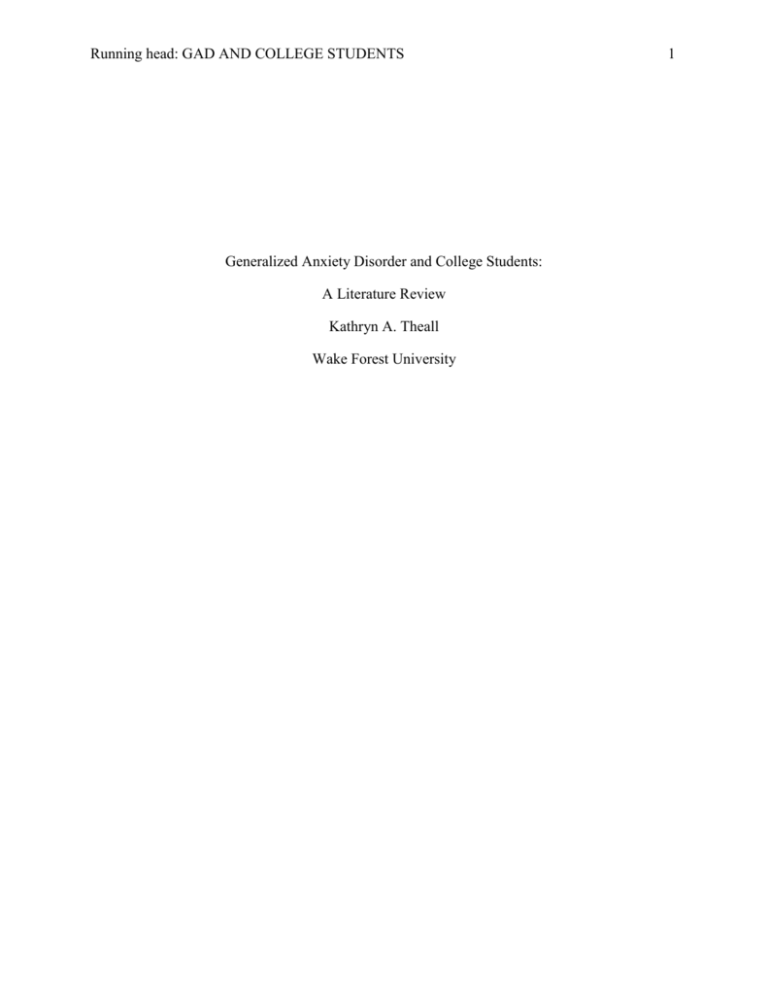
Running head: GAD AND COLLEGE STUDENTS Generalized Anxiety Disorder and College Students: A Literature Review Kathryn A. Theall Wake Forest University 1 2 GAD AND COLLEGE STUDENTS Abstract Generalized anxiety disorder (GAD) is characterized by excessive worry interfering with an individual’s ability to complete everyday tasks. For individuals with GAD, the anxiety lasts for a long period of time and invades other aspects of their life. It is usually accompanied with physical symptoms such as troubled sleep patterns, restlessness, difficulty focusing, and tense muscles. Though the reported median age of onset for GAD is 30 years of age, it affects 0.9% of adolescents/young adults in the United States (American Psychiatric Association, 2013). The current manuscript analyzes recent peer-reviewed, published articles concerning GAD and undergraduate students from the year 2000 to present. Electronic databases such as ERIC and PsycINFO were used to locate research materials contained in this literature review. Attitudes and characteristics, substance abuse, and treatment are summarized in the context of GAD and college students. Potential areas for future recommended research topics are also presented. 3 GAD AND COLLEGE STUDENTS Introduction A hallmark of Generalized Anxiety Disorder, or (GAD), is extreme amounts of worry and anxiety surrounding a variety of situations. Worrisome thoughts are pervasive and interfere with tasks associated with daily living. GAD is also characterized by excessive worry about future events and outcomes. The DSM-V sites several factors distinguishing GAD from nonpathological worry. Suffers are unable to put excessive worry aside, and worry affects psychosocial functioning. Concerns are about a wide range of life events and occur more often than nonpathological worry. Physical symptoms are typically linked to episodes of worry. GAD can appear at any age, but rarely manifests before adolescence. A key difference in adult GAD and adolescent/child GAD is the subject matter of the worries afflicting the sufferer. Teens and children tend to display worries concerning school performance (American Psychiatric Association, 2013). Typically, younger adults have more severe symptoms than older adults (American Psychiatric Association, 2013; Nuevo, Ruiz, Izal, Montorio, Losada, & MarquezGonzalez, 2008). Dugus, Gagnon, Ladouceur, and Freeston (1998) established a conceptual model for GAD based on theory. The model focuses on intolerance of uncertainty, beliefs about worry, poor problem orientation, and cognitive avoidance. Intolerance of uncertainty was the most salient feature of the model when comparing GAD patients and non-clinical control subjects. Intolerance of uncertainty, beliefs about worry, poor problem orientation, and cognitive avoidance were all found to be effective in distinguishing GAD patients from non-clinical patients. GAD patients may also have difficulty with interpersonal functioning and relationships (Dugus, et al., 1998 as cited by Eng & Heimberg, 2006). 4 GAD AND COLLEGE STUDENTS According to the American College Health Association (2007), 16.3% of college students’ academic performance was negatively affected by mental health issues such as anxiety or depression on a self-reported survey. Anxiety disorders affected 13.4% of college students in the past year (American College Health Association, 2007). Eisenberg, Hunt, and Speer (2013) suggest that understanding mental health and other individual-level factors (like comorbid health conditions, financial situation, etc.) can aid universities in designing effective intervention services and identify need within the student body. College students are a unique population, and not all findings will apply to them. Therefore, it is crucial to increase understanding about availability of mental health services, the campus environment, and individual-level factors affecting the mental health of college students in American colleges (Eisenberg, et al., 2013). Methods The Wake Forest University Z. Smith Reynolds Library website was consulted to find empirically-based, peer reviewed articles for the current literature review. Through the Wake Forest University Z. Smith Reynolds Library website, searches in the ERIC and PsycINFO databases yielded results on the characteristics of GAD in college student samples. Search terms included “Generalized Anxiety Disorder,” “GAD,” “Generalized Anxiety Disorder and Undergraduates,” “Generalized Anixety Disorder, College Students, and Treatment,” and Generalized Anxiety Disorder and College Students.” Search terms were limited between the years 2000-2013, by sample with “undergraduates,” and only peer-reviewed articles. Constricting the search to these specific search terms yielded 10 articles or less. Articles were also limited by subject age ranging from age 18-24 years old. Most articles were immediately available online as .PDF files, but some were requested using the Interlibrary Loan system. Most of the sources used in the current study came from PsycINFO and were Level IV evidence: non-experimental, descriptive studies (i.equestionnaires.) Some cross-sectional studies and controlled longitudinal studies were also utilized. 5 GAD AND COLLEGE STUDENTS Results Diagnosis. Generalized Anxiety Disorder can affect a wide range of people and differs from nonpathological anxiety because it is frequent, pervasive, distressing, and usually accompanied by physical symptoms (i.e- restlessness, shaking, trouble sleeping, and muscle tension.) For a confirmed diagnosis of GAD, the following criteria needs to be considered: “A. Excessive anxiety and worry (apprehensive expectation), occurring more days than not for at least 6 months, about a number of events or activities (such as work or school performance). B. The individual finds it difficult to control the worry. C. The anxiety and worry are associated with three (or more) of the following six symptoms (with at least some symptoms having been present for more days than not for the past 6 months): 1. Restlessness or feeling keyed up or on edge. 2. Being easily fatigued. 3. Difficulty concentrating or mind going blank. 4. Irritability. 5. Muscle Tension 6. Sleep disturbance (difficulty falling or staying asleep, or restless, unsatisfying sleep). 6 GAD AND COLLEGE STUDENTS D. The anxiety, worry, or physical symptoms cause clinically significant distress or impairment in social, occupational, or other areas of functioning. E. The disturbance is not attributable to the physiological effects of a substance or another medical condition. F. The disturbance is not better explained by another mental disorder” (pp. 222). GAD’s median onset age is 30 years of age; but it can occur at any time. Individuals are chronically affected, and experience GAD as fading and becoming more prevalent over the course of a lifetime (American Psychiatric Association, 2013). Though GAD rarely manifests before adolescence, it is documented that younger adults experience more severe symptoms than older adults (American Psychiatric Association, 2013; Nuevo et al., 2008). Because younger adults experience symptoms differently than older adults, it has been disputed that criteria for diagnosing GAD in older adults is biased (Nuevo, et al., 2008). GAD has also been known to be overdiagnosed in children. Some risk factors for GAD include: parental overprotection, childhood adversities, negative affectivity, behavioral inhibition, and harm avoidance (American Psychiatric Association, 2013). Assessment. The present literature review includes studies that use the Generalized Anxiety Disorder Questionnaire-IV (GAD-Q-IV; Newman, Zuellig, Kachin, Constantino, Przeworski, Erickson, & Cashman-McGrath, 2002), the Penn State Worry Questionnaire (PSWQ; Meyer, Miller, Metzger, & Borkovec, 1990), and the Intolerance of Uncertainty Scale (IUS: The English version; Buhr & Dugas, 2002) to assess self-reports of GAD in participants. The GADQ-IV displays test-retest reliability, discriminant validity, 89% specificity, and 83% sensitivity, making it a reliable measure of GAD patients compared to non-clinical patients (Newman et al., 7 GAD AND COLLEGE STUDENTS 2002). The PSWQ significantly determined (in a sample of college students,) participants who displayed some or all GAD symptoms compared to other disorders. The PSWQ displayed testretest reliability and did not correlate with other measures of anxiety or depression (Meyer et al., 1990). Intolerance of uncertainty is a key factor when assessing worry and GAD. The IUS displays good test-retest reliability, internal consistency, and convergent and divergent validity (Buhr & Dugas, 2002). Characteristics of GAD. The cognitive behavioral model developed and tested by Dugas et al. (1998) showed that intolerance of uncertainty, beliefs about worry, poor problem orientation and cognitive avoidance showed a significant effectiveness in determining GAD patients from a non-clinical control group. Intolerance of uncertainty was found to be the most salient process variable when confirming GAD (Dugas et al., 1998). Intolerance of uncertainty remains an important factor in assessing GAD (Dugas, et al., 1998; Miranda, Fontes, Marroquin, 2008). One of the most prevalent features of GAD is worrying about anticipated events. High intolerance of uncertainty (IU) is related to diagnosis of GAD when compared to non-clinical participants (Dugas, et al., 1998). Miranda et al., (2008), attempted to identify specific cognitive content to discriminate anxious versus depressive thinking. Using a sample of 284 college students ages 18-48 (M=20.48), investigators found that IU predicted GAD and depression over a period of 6 weeks. However, IU had a stronger relation to depression than GAD over a long period of time. Both GAD and depression showed a positive relationship to certainty regarding negative anticipated events. Results support that GAD is distinguished by negative thinking, physiological arousal, and increased negative affect (Miranda et al., 2008). 8 GAD AND COLLEGE STUDENTS Similarly, Miranda and Mennin (2007) examined GAD and depression and individual’s predictions about the future. The level of certainty in individuals’ predictions was also assessed. Sixty-five undergraduates ages 18 to 38 (M= 21.1) participated in the study. Certainty regarding negative future events had a positive relationship with higher GAD symptoms. Higher GAD symptoms were also shown to be related to being certain more frequently about negative future events. Anxiety did not show a correlation with predicting the non-occurrence of positive events (Miranda & Mennin, 2007). Thus, hopelessness may be a moderating variable when comparing GAD and depression and prediction of negative events (Miranda et al., 2008). MacLeod and Cohen (1993) found that in a sample of trait-anxious college aged students (ages 17-25, M= 18.0), participants assigned threatening bias to ambiguous sentences. Therefore, anxious individuals have a higher likelihood of assigning a threatening bias to ambiguous stimuli (MacLeod & Cohen, 1993). Hazlett-Stevens and Borkovec (2004) replicated MacLeod and Cohen’s study with the exception of assessing whether or not GAD individuals use prior information to interpret ambiguous stimuli. Researchers also examined if GAD individuals used prior cues to assess ambiguous stimuli if there was no threat present. Twenty-six GAD and nonanxious college students completed homograph word tasks. GAD individuals were more likely than non-anxious individuals to use prior cues to determine ambiguity in the threat/neutral homographs. Slower reaction times were recorded in the GAD group when the prior cue’s meaning was different and not in the non-anxious group. Though GAD individuals may have had an interpretive bias in assigning threat to ambiguous words, they did not do this when there was no potential for threat (Hazlett-Stevens & Borkovec, 2004). Individuals with GAD may have issues with interpersonal function and relationships (Dugas et al., 1998). According to the DSM-V, one criteria of a GAD diagnosis is anxiety that 9 GAD AND COLLEGE STUDENTS negatively affects psychosocial functioning (American Psychiatric Association, 2013). Eng and Heimberg (2006) sought to study the interpersonal difficulties experienced by those with GAD and how they are perceived by their friends. The sample consisted of college-aged students, 48 determined to be GAD symptomatic and 53 as non-anxious controls. Participants also recruited a “close friend” to measure how participants are perceived by friends in their interpersonal environment. It was found that GAD individuals reported higher levels of interpersonal problems including nonassertiveness, over-accommodation, self-sacrificing behaviors, neediness, and intrusiveness. Social inhibition was also another common theme found within the GAD group. GAD individuals craved closeness in relationships but would often become submissive in relationships. Low self-esteem was also reported, along with a fear of others’ disapproval. GAD participants also claimed they had poor interpersonal boundaries and tended to take-on others’ problems. Though less secure parental attachment is a potential characteristic of GAD, it did not affect the social support available to GAD individuals (American Psychiatric Association, 2013; Eng & Heimberg, 2006). Eng and Heimberg’s (2006) hypothesis was disproven by the data concerning the close friends recruited by study participants. GAD individuals did report higher interpersonal difficulty than the non-anxious control group, but close friends of GAD individuals rated them no differently than the friends of the control group. One reason for this may be that GAD individuals may have more trouble reading others’ reactions and therefore have unrealistic views of how others perceive them. Perhaps GAD participants did not share interpersonal difficulties with their recruited friend, and therefore friends would not be aware (hence why it would be unreported in the data.) Researchers drew an optimistic conclusion for GAD individuals being 10 GAD AND COLLEGE STUDENTS able to have close friendships that are mutually beneficial for both parties (Eng & Heimberg, 2006). The Mental Health of College Students and Anxiety. Though there is an abundance of information on the status of college students and mental health, few studies examine specific correlations of variables surrounding college students and mental health (American College Health Association, 2008; Eisenberg et al., 2013). Mental health problems exist in high levels in college student populations in American universities (American College Health Association, 2008). Eisenberg and others (2013) call for a greater understanding regarding the individual factors that could help identify high-risk students, aid universities in providing appropriate services, and designing intervention programs. The college population is unique when compared to other populations due to its exclusive nature and the campus environment. A campus can affect a student’s mental health in a number of ways, ranging from availability of mental health services, academic rigor, and interpersonal environments (Eisenberg et al., 2013). Eisenberg and others (2013) collated data from two national surveys called the Healthy Minds Study, available from October to November 2007 and in March to April 2009. The data from these surveys reflected a wide range of schools. At each school, researchers selected a sample of 1,000 students of undergraduate and graduate status with the exception of two larger schools. The final sample size allowed for 32,133 students. Positive screens for generalized anxiety and anxiety disorders yielded 7.0% and 9.8% respectively. Over half (55%) of the sample reported that mental health issues affected their academic performance at least one day in the past month. Many students had a prior diagnosis of a mental disorder by a health professional (24.4%), including 12.1% who reported an anxiety disorder. Of the students who suffered from depression, 40% also reported having generalized anxiety. Overall, more anxiety 11 GAD AND COLLEGE STUDENTS was found in female students (22%), in students of non-Asian descent, in students of multiple races/ethnicities, students attending smaller private schools, and student experiencing financial stress in the present or past. Researchers suggest creating a program for students experiencing financial stress to receive mental health services. Advocating for mental health services for the colleg student population is of great importance due to the prevalence of mental health problems on American campuses (Eisenberg et al., 2013). Substance Use Behaviors. It is well-documented that college students display substance use behaviors (American College Health Association, 2008). Cranford, Eisenberg, and Serras (2009), advocate a greater understanding of substance use behaviors in college students and mental health. Researchers examined the following research questions: “1) What is the prevalence of substance use behaviors in college students, overall and by gender and by academic level? 2) How are the substance use behaviors associated with mental health problems and, do these patterns of co-occurrence vary by gender/academic level? 3) What proportion of students with a particularly risky type of co-occurrence- frequent binge drinking and mental health problems- receive mental health services?” (pp. 135). Though students were asked generally about mental health problems, for the purposes of this literature review the summary will focus on anxiety and GAD-related data. The sample yielded a total of 2,843 students, 94.1% were undergraduates in the “18-22 year-old” group. GAD had a positive relationship to frequent binge drinking, especially in males. Men may have more positive expectancies surrounding alcohol than females, thus accounting for alcohol consumption being used to reduce anxiety symptoms. GAD was also highly associated with smoking. 12 GAD AND COLLEGE STUDENTS Students who displayed comorbidity in binge-drinking and mental health problems (67%) perceived a need for assistance with their mental health problems, but only 38% said they had sought mental health services that year (Cranford et al., 2009). Cranford and others (2009) agree with Eisenberg and others (2013), that there is an unmet need for mental health services in the college student population; particularly as it relates to substance use behaviors (Cranford et al., 2009; & Eisenberg et al., 2013). Suicidal Ideation Among College Students and GAD. Shtayermman, Fayda, and Knight (2013) examined the college student population (ages 18-24 years old) and risk factors for suicide. Out of the 493 that participated, 95 returned for the 6-month follow-up. Self-reported data yielded that 17.9% met criteria for GAD. Moderating variables for suicidal ideation were depressive symptoms, presence of anxiety, and high relational victimization scores. Researchers found significant difference in suicidal ideation for GAD individuals compared to non-clinical individuals. Suicidal ideation also appeared in individuals with GAD and high relational victimization. Overall, GAD individuals (along with Major Depressive Disorder individuals) displayed more suicidal ideation (Shtayermman et al., 2013). Physiological Symptoms and GAD. Along with the many psychological symptoms of GAD, GAD is also characterized by a many physiological symptoms like muscle tension, trouble sleeping, and restlessness (American Psychiatric Association, 2013). Drews and Hazlett-Stevens (2007), examined the relationship between Irritable Bowel Syndrome (IBS) and the psychological constructs of GAD using a sample of 391 college students. Researchers found 21.7% of participants met the diagnosis for GAD, 10.7% were considered to have IBS, and 4.3% had both GAD and IBS. IBS individuals were more likely to also met criteria for GAD. It was also found that IBS individuals had greater experiential avoidance compared to those without 13 GAD AND COLLEGE STUDENTS IBS. IBS individuals also experienced greater trait anxiety and worry. Researchers proposed that if physiological symptoms are thought to be threatening by the individual, then rumination and hypervigilance over the symptoms could occur. Conditioned fear responses could perpetuate the physiological symptoms of IBS. While those with IBS and GAD share some similarities in avoidance of fear and unwanted external stimuli, specific psychological constructs that characterize GAD cannot be applied to IBS individuals (Drews & Hazlett-Stevens, 2007). Treatment. GAD individuals display interpersonal difficulties, as well as some unique cognitive constructs (American Psychiatric Association, 2013; Eng & Heimberg, 2006; Dugas et al., 1998). Rezvan, Baghban, Bahrami, and Abedi (2008) compared cognitive behavior therapy (CBT) with cognitive behavior therapy combined with interpersonal therapy (CBT+IPT) in 36 GAD undergraduate individuals. Researchers examined whether or not IPT enhanced the effectiveness of CBT over time; as well as overall levels of happiness. It was found that CBT+IPT had greater long-lasting effects in treating GAD individuals than did just CBT alone. In the follow-up test, participants had lower overall worry level and higher levels of happiness. It is hypothesized that the CBT+IPT therapy was more effective because it included emotions as well as behaviors and cognitions (Rezvan et al., 2008). GAD individuals want to have close relationships, but tend to be nonassertive and submissive in relationships (Rezvan et al., 2008; Eng & Heimberg, 2006). In the CBT+IPT condition, participants learned interpersonal skills as well as new behaviors and cognitions. Learning new interpersonal skills coupled with CBT allowed for longer-lasting therapeutic effects. This evidence supports that combining CBT and IPT is an effective intervention for GAD individuals experiencing relapse after psychotherapy (Rezvan et al., 2008). 14 GAD AND COLLEGE STUDENTS Discussion College students are an extremely unique population due to a variety of factors like exclusive population make-up, interpersonal issues, academic demand, and campus setting Mental health issues are pervasive in colleges across the United States (American College Health Association, 2008; Eisenberg et al., 2013). Generalized Anxiety Disorder is a complex disorder that encompasses psychosocial, physiological and cognitive aspects of an affected individual (American Psychiatric Association, 2013). Though there is a wealth of research on GAD, much of it does not examine GAD specifically because GAD often occurs with other disorders (American Psychiatric Association, 2013). Knowledge of college student mental health is welldocumented, but there is little research specifically examining GAD and college students (Eisenberg et al., 2013; American College Health Association, 2008). Several factors are characteristic of the college student population, like substance use behavior and interpersonal difficulty (Eisenberg et al., 2013; Cranford et al., 2009; Eng & Heimberg, 2006). Much of the data in the present literature review was based on self-reported data, and not randomized control groups. Areas of future research include studies examining GAD specifically within the context of a college student population. Substance use behavior and interpersonal concerns should be assessed. A study designed to examine the content of GAD college students’ worry could provide insight regarding the structure of GAD as it exists in college students. Longitudinal data would provide greater understanding of how GAD affects college students over time (freshman versus seniors, etc.) Rezvan and others (2008) found CBT+IPT to be effective in treating a small sample of undergraduates (N=36) that met criteria for GAD. A larger sample could lead to more generalizability of these results applied to other sections of the college student population. Other 15 GAD AND COLLEGE STUDENTS approaches to therapy combined with IPT may be other avenues of worthy research within the college student population. College students are an underserved population, and any research that adds to the understanding of the mental health of college students could lead to the discovery of more effective interventions and program designs (Eisenberg et al., 2013). 16 GAD AND COLLEGE STUDENTS References American Psychiatric Association (2013). Generalized anxiety disorder. Diagnostic and Statistical Manual of Mental Disorders (5th ed). Washington, DC: Author American College Health Association (2008). American college health association- National college health assessment: Reference group data report spring 2007. Journal of American College Health. 56, 67-79. Buhr, K., & Dugas, M.J. (2002). The intolerance of uncertainty scale: psychometric properties of the English version. Behaviour Research and Therapy, 40(8), 931-945. Cranford, J. A., Einsenberg, D., & Serras , A. M. (2009). Substance use behaviors, mental health problems, and use of mental health services in a probability sample of college students. Addictive Behaviors,34, 134–145. Drews, A., & Hazlett-Stevens, H. (2008). Relationships between irritable bowel syndrome, generalized anxiety disorder, and worry-related constructs. International Journal of Clinical and Health Psychology, 8(2), 429-436. Dugus, M. J., Gagnon, F., Ladouceur, R., & Freeston, M. R. (1998) Generalized anxiety disorder: A preliminary test of a conceptual model. Behaviour Research and Therapy, (36), 215-226. Eisenberg, D., Hunt, J., & Speer, N. (2013). Mental health in american colleges and universities: Variation across student subgroups and across campuses .The Journal of Nervous and Mental Disease, 201(1), 60-67. Eng, W., & Heimberg, R. G. (2006). Interpersonal correlates of generalized anxiety disorder: Self versus other perception. Anxiety Disorders, 20, 380-387. 17 GAD AND COLLEGE STUDENTS Hazlett-Stevens, H., & Borkovec, T. D. (2004). Interpretive cues and ambiguity in generalized anxiety disorder. Behaviour Research and Therapy, 42, 881-892. MacLeod, C., & Cohen, I.L., (1993). Anxiety and the interpretation of ambiguity: A text comprehension study. Journal of Abnormal Psychology, 102(2), 238-247. Meyer, T.J., Miller M.L., Metzger R.L., Borkovec, T.D. (1990) Development and validation of the penn state worry questionnaire. Behaviour Research and Therapy, 28(6), 487-495. Miranda, R., Fontes, M., & Marroquin, B. (2008). Cognitive content-specificity in future expectancies: Role of hopelessness and intolerance of uncertainty in depression and gad symptoms. Behaviour Research and Therapy, 46, 1151–1159. Miranda, R., & Mennin, D. S. (2007). Depression, generalized anxiety disorder, and certainty in pessimistic predictions about the future. Cognitive Theory Research, 31, 71-82. doi: 10.1007/s10608-006-9063-4 Newman, M.G., Zuellig A.R., Kachin K.E., Constantino M.J., Przeworski A., Erickson T., & Cashman-McGrath, L. (2002) Preliminary reliability and validity of the generalized anxiety disorder questionnaire-IV: A revised self-report diagnostic measure of generalized anxiety disorder. Behavior Therapy, 33, 215-233. Nuevo, R., Ruiz, M. A., Izal, M., Montorio, I., Losada, A., & Marquez-Gonzalez, M. (2008). A comparison of the factorial structure of the dsm-iv criteria for generalized anxiety disorder between younger and older adults. Journal of Psychological Behavioral Assessment, 30, 252-260. doi: 10.1007/s10862-008-9084-2 18 GAD AND COLLEGE STUDENTS Rezvan , S., Baghban, I., Bahrami, F., & Abedi, M. (2008). A comparison of cognitive-behavior therapy with interpersonal and cognitive behavior therapy in the treatment of generalized anxiety disorder. Counselling Psychology Quarterly, 21(4), 309-321. Shtayermman, O., Fayda, M. G., & Knight, K. L. (2013). Risk factors for suicidal ideation among college students: 6-month follow-up. International Quarterly of Community Health Education, 33(1), 69-82.

